
9 minute read
Deep tunnel sewerage systems: Singapore’s success story
from IMIESA April 2022
by 3S Media
The City of Singapore (Credit: Darya Jum)
Advertisement
Singapore’s pioneering role in developing deep tunnel sewerage systems (DTSSs) serves as a prime example of what could be replicated by South African cities. Across the world, cities face similar challenges in terms of intensified urbanisation, poulation growth and the need to modernise decades-old wastewater infrastructure using best practice techniques.
By Frank Stevens & Swen Weiner*
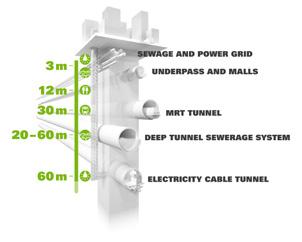
According to the UN, 9.8 billion people will be living on the planet by 2050, with growth particularly coming from Africa and Asia. A total of 70% of that population will be urban, a 1.7-fold increase compared to 2015.
Cities will have to invest massively in sewage handling capacity to serve this growing population, while climate change will further stress capacity. Additionally, extreme weather is confronting cities with high amounts of rainwater to be collected, discharged and – at least partly – treated within a short period. Diminishing surfaces for infiltration add to the problem by leaving fewer opportunities for rainwater to drain naturally. In addition, many cities want to reuse sewage instead of discharging it into nearby rivers.In Singapore’s case, this sovereign island city-state has an area of 730 km2 and a population of 5.7 million people. In addition to having the second highest population density in the world, this country boasts the second highest GDP per capita globally and Singaporeans enjoy one
Tunnel types in Singapore’s underground infrastructure system
of the world’s longest life expectencies. Keeping up with economic growth is a clear priority, and with limited land space available, the installation of underground services is a preferred option.
A DTSS is – especially from an operation cost point of view – a very cost-efficient solution to meet long-term needs for wastewater collection, treatment and disposal. Deep sewer systems involve large-diameter main tunnels that convey wastewater by gravity to centralised treatment plants, mostly located outside cities. Smaller-diameter, often pipe-jacked, link sewers and deep shafts are further parts of these schemes. Construction of such large-scale schemes is quick and safe, with minimal impact on population and environment.
Water security
A key challenge facing Singapore is ensuring the security of its water supply, which is derived from three sources: • Imported Water 40% of Singapore’s water is imported from the Johor catchment in Malaysia via a 1 km causeway. Singapore has an obligation to supply 2% of this water back to Malaysia once treated and the agreement expires in 2061. • Reclaimed Water 30% of Singapore’s supply is presently obtained from five state-of-the art treatment works. This ultra-clean water, known as 'NEWater', is used for both domestic and industrial consumption. • Desalinated Water 30% of its need is obtained from Singapore’s four desalination plants. Each uses the energy-intensive reverse osmosis process.
Wastewater
Within the wastewater space, the Singapore DTSS route is coined as ‘Singapore’s Sanitary Superhighway’ by the country’s National Water Agency. The project consists of two phases and will finally comprise some 200 km when competed.
Completed in 2008, DTSS Phase 1 was installed in the eastern part of Singapore. The system is made up of deep tunnels and link sewers that convey effluent to the Changi water reclamation plant and sea outfall situated in the south-east of the island.
The main focus of this discussion is on DTSS Phase 2, which is now under way. This system extends to the south-western part of the island and will feed effluent to the new Taus water reclamation plant. It will consist of 40 km of deep tunnels, 60 km of link sewers, and a specialised industrial sewer network. The main South Tunnel will vary in depths ranging from 35 m to 55 m.
The deep tunnels will connect with the existing used water infrastructure to create one seamless and integrated system.
DTSS 2 construction stages
The client chose to break Phase 2 into five tunnelling contracts as described below: • Contract T-07: Four Mixshield tunnel boring machines (TBMs) constructing 12 km of tunnels and odour control shafts (diameters: 7.56 m and 4.86 m). • Contract T-08: Four Mixshield TBMs constructing 10 km of tunnels serving the industrial area and two undersea tunnels (diameters: 7.46 m and 4.35 m). • Contract T-09: Three Mixshield TBMs constructing 8 km of tunnels (diameter: 7.51 m). • Contract T-10: Two Mixshield TBMs and one EPB Shield machine constructing 8 km of tunnels (diameter: 4.78 m up to 7.41 m). • Contract T-11: Five Mixshield TBMs and
Vertical Shaft Sinking (VSM) equipment (diameter: TBMs, 4.23 m and 4.53 m;
VSM, 11.2 m). Many benefits are to be gained by using an entirely gravity-fed deep sewer system, as is the case for DTSS Phase 1 and 2.
In Singapore’s case, this sovereign island city-state has an area of 730 km2 and a population of 5.7 million people. In addition to having the second highest population density in the world, this country boasts the second highest GDP per capita globally and Singaporeans enjoy one of the world’s longest life expectencies.”
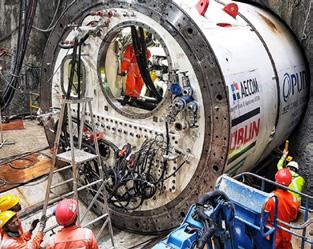
TBM assembly in launch shaft Breakthrough of Mixshield ID 3505 in shaft
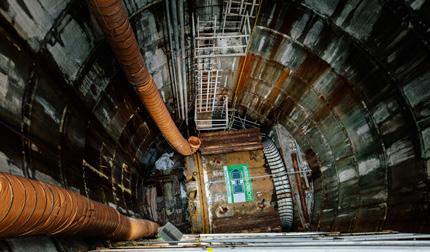
The need for constructing new intermediate pump stations is eliminated and a number of old existing pump stations will be removed, thus releasing valuable land for housing development and reducing energy costs. Obstacles at shallower depths are easily avoided – e.g. the South Tunnel passes well below busy freeways, large buildings, a section of seabed and many existing services.
The tunnels will be lined concrete segments with a secondary inner HDPE lining, which will eliminate the threat of corrosion. Tunnel condition monitoring will be undertaken via a system of fibreoptics within the tunnel lining and the need for human entry for inspection will be drastically reduced. Odour control will be achieved by using forced ventilation shafts.

First shaft construction ID 10000 with VSM
Equipment selection
Two of the many issues that must be considered when deciding on the best machine to use for a particular job are the geological and groundwater conditions. It is vital that the soil properties (i.e. grain size, compactness and consistency) and the rock properties (i.e. compressive strength, tensile strength and RQD index) are accurately determined and catered for.
Complex geological conditions were encountered on this project. The tunnels pass through the Jurong formation, which is made up of a mix of limestone, sandstone and argillite – a sedimentary rock with a high clay and silt content. The Mixshield TBM concept was chosen as the best option due to its ability to handle heterogeneous ground conditions and its ability to withstand very high water pressures. Safe working conditions are achieved using a hydraulic support system of slurry suspension, together with a controlled air cushion system to assure face support.
Excavated material is removed through a closed slurry circuit and hydraulic thrust cylinders within the shield area push the machine forward. The cutting wheel is made up of both knives and disc cutters, and boulders and stones are crushed and screened to a manageable grain size for conveying to the surface. The same
Vertical Shaft Sinking Machine (VSM) machine concept – the AVN machine with cone crusher – has also been used for the pipe-jacked link sewer tunnels.
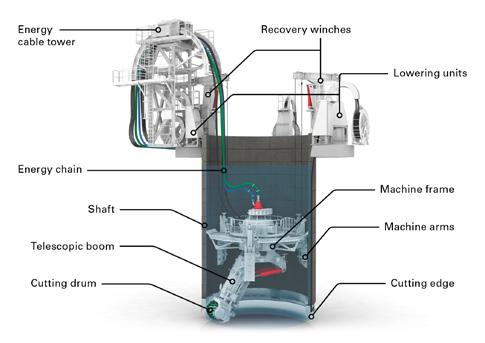
VSM
This is the first time that VSM technology has been used in Asia. This equipment has made it possible to complete three shafts with an ID of 10.0 m (at depths up to 56 m).
Challenges that had to be overcome include fines with clogging potential, areas of highly abrasive rock, varying geology, and groundwater that was, at times, 2 m from the surface with lowering of the water table not being permissible. Two of the shafts were situated less than 2 m apart.
Some of the benefits derived from VSM technology include safe working conditions and a continual construction process, with sinking rates of up to 5 m/day, depending on shaft diameter and ground conditions. Shafts for odour control, air jumpers and drop shafts that lead to the main tunnels are required.
A hydraulically powered cutting drum – equipped with excavation tools and controlled by a telescopic boom – loosens the soil on the shaft bottom. The excavated material is removed to the surface using a submersible pump. Excavation is undertaken below the water table, while the operation is completely controlled from the surface.
The shafts are lined with precast concrete segments. The shaft lining is installed at the surface and is in most cases made up from precast concrete segments. Alternatively, in situ concrete casting of
the shaft walls can also be implemented. In this case, the slower progress of shaft construction works is compensated for to some extent by having a ‘continuous’ structure, without joints, and by the possibility of integrating entire entry and exit structures for tunnelling activities in the walls of the shaft. A combination of in situ lining for the bottom part of the shaft and subsequent lining with segments has been implemented in Singapore.
The Tuas water reclamation plant
Effluent will be fed via the Southern Tunnel and then treated at the new Tuas wastewater reclamation plant. Once fully operational, its output will increase the amount of reclaimed water use in Singapore from 30% to 55% of its total.
The plant’s output will be 800 Mℓ/day. This purified water will be sold as potable NEWater and to industry. Any excess treated water will be discharged into sea outfalls. Thanks to this project, the older Jurong and Ulu Panda recycling plants will eventually be phased out.
State-of-the-art design ensures higher energy efficiencies and features such as the use of membrane reactors (which replace the need for primary sedimentary tanks, bioreactors and secondary sedimentation tanks), and this will result in a smaller footprint of the plant. Reverse osmosis and UV disinfection will form part of the treatment process. Biogas will be used to reduce energy dependency.
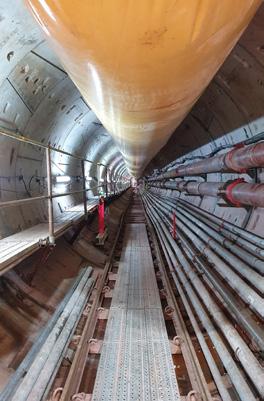
Conclusion
Singapore’s Sanitary Superhighway shows that deep sewers offer an effective solution for cities to collect and centrally treat their wastewaters, thus adding capacity to their systems and simultaneously freeing up valuable space for development. TBMs and VSM machines help to execute such projects quickly, safely and with minimum impact on the population and environment. They offer solutions for the prevailing geological and hydrogeological conditions and can excavate at the extreme depths required.
In South Africa, and Africa as a whole, government departments, utilities and consultants should explore and consider the benefits of employing deep tunnelling solutions for projects with similar demands and conditions as those encountered in Singapore. *Herrenknecht AG (Utility Tunnelling Business Unit), Germany
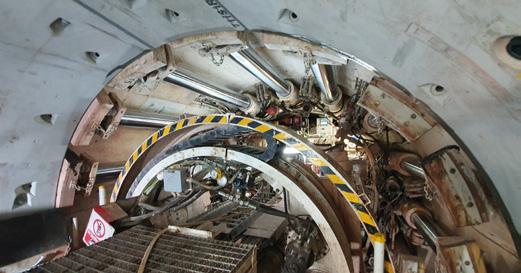
Segment lining with Mixshield ID3755
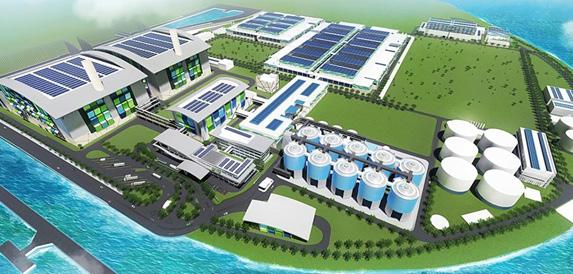
Tuas water reclamation plant
This is an edited version of a paper presented at the 2021 IMESA Virtual Conference. For the full paper, visit www.imesa.org.za/conference-2021.
View in tunnel with Mixshield ID3755










